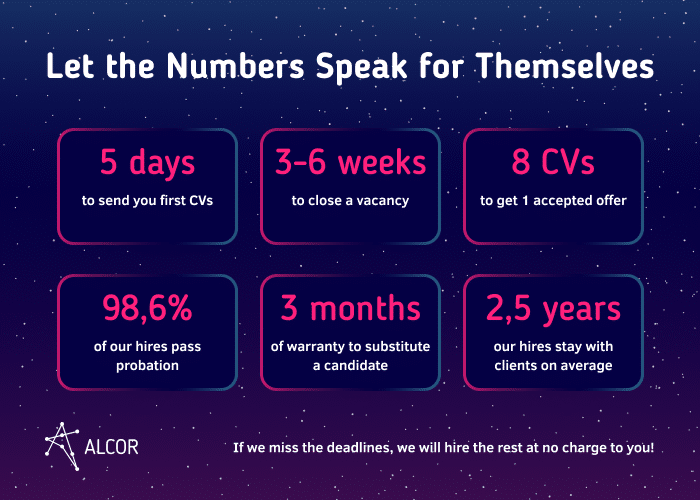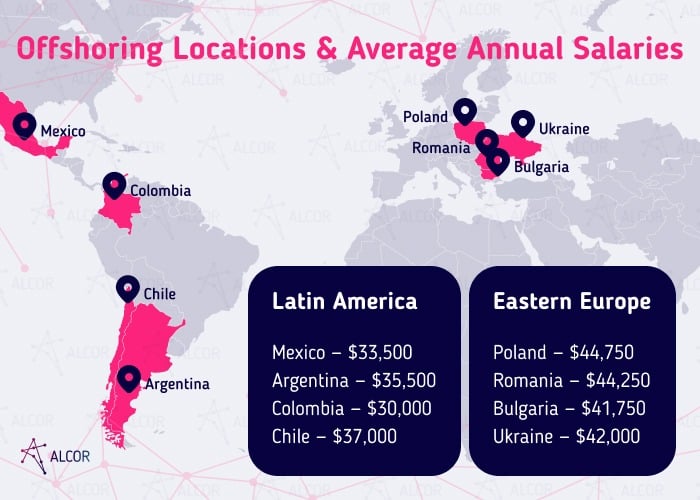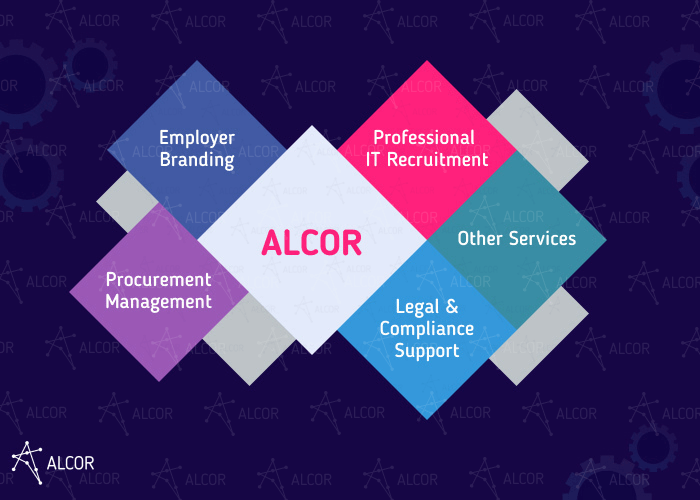Today, more and more IT entrepreneurs are implementing innovative approaches to doing business. The global economic downturn, shortages in tech talent, and rising expenses are pushing companies to strive for higher efficiency and greater adaptability in the interconnected world. That’s how business process outsourcing (BPO) came to the foregroundto empower IT enterprises to accelerate growth while significantly reducing costs.
I’m Dmytro Ovcharenko, founder and CEO of Alcor, your ultimate all-in-one solution for R&D center, IT recruitment, and EOR services. With 7+ years of helping product software businesses launch their offices in Eastern Europe and Latin America, we at Alcor have aced all the do’s and don’ts of offshoring.

While there are numerous instances of successful offshoring solutions implemented by corporations, it’s not without its challenges. Thus, I’d like to give some insights on how to offshore software development and share both triumphant and not-so-good outsourcing and offshoring stories, so you will spare yourself from painful lessons and adopt only the best practices for your IT company instead.
What is Offshoring?
Offshoring in its meaning is the relocation of a whole or a part of the business to foreign locations for the sake of receiving higher-quality services, accessing bigger talent pools, reducing financial expenses, and obtaining scalability opportunities.
When to Use Offshore Software Development Services?
Your Business Is Mature
Once your company boasts a solid client base and maintains consistent yearly revenue growth, you are ready for offshoring. At this point, you can tally the taxes and salary costs you will potentially save with the move and weigh its fit within your business model.
You Need Maintenance & Support
Picture this: your products and services are fully fleshed out and rigorously tested. Now, scaling up requires ongoing maintenance and support, and offshoring is an excellent means of achieving that. One vivid example of that is offshore Salesforce development. Notably, you’ll only divulge data related to product deployment, safeguarding your precious source code.
The Project Does Not Involve IP
IP rights often stand in the way of offshoring, as you play with fire when sharing your code with third parties. Certain offshoring models, however, offer secure data protection. But if you don’t want to bother with this, just choose non-IP-based projects. Think operational support-centric tasks, testing, or design — lower costs, zero risk, no IP concerns.
It Is a Long-Term Plan
Offshoring is worth the toil if the project you take off your shoulders is not short-lived. Ideally, you should always keep the long game in sight. Rushed offshoring rarely pays dividends; instead, aim for a comprehensive strategy that truly reflects the time and effort you’ve poured into it.
You Seek Skilled Talent
Tech-savvy talent is not a dime a dozen. In fact, it’s increasingly challenging to find. According to Deloitte, 50% of executives classify talent acquisition as their top internal challenge, while 62% acknowledge being unprepared to address employee retention issues.
For example, cybersecurity is the predominant area short of tech specialists, so 81% of executives cover their needs via third-party vendors. At the same time, 48% of them still manage their back office functions internally.
Deloitte argues for global in-house centers as a solution to these issues. Another name for this model is an R&D center. It implies launching an office in a lower-cost location while benefiting from local talent and their tech expertise. The R&D team is yours from the very beginning, which means no risks to your sensitive data. Finally, your back office and legal operations are also handled.
9 Successful Offshoring Examples
There’s a whole checklist to tick off before diving into the offshoring journey, and consistency is the name of the game. Hence, go through a defined to-do list when choosing where and how to offshore your tech business.
The big question: “Where to offshore?” The success stories of offshoring companies underline the importance of your destination. Eastern Europe and Latin America stand out as advantageous offshoring regions. The list of real cases below provides concrete evidence to back this up.
1. WhatsApp
Offshoring enables your in-house team to focus on the most relevant challenges for your business. Right before WhatsApp was launched in 2009, the company offshored its software development to Eastern Europe. While WhatsApp relied on offshore talent to handle the tech groundwork providing design solutions and taking care of core app development, their in-house engineers concentrated on client-related tasks, such as customer support. This strategic division paved the way for WhatsApp’s rise to the top of both the AppStore and Google Play. This situation forced Facebook to face its formidable rival by acquiring WhatsApp for a staggering $19 billion — the largest acquisition at the time for a venture capital-funded company.
2. Google
Google joined the ranks of successful offshoring companies in 2020 by venturing into Eastern Europe. They established a software development team through the acquisition of CloudSimple. Despite Google having the world’s largest team of developers, this move highlights their passion for advancement and innovation. CloudSimple, now part of Google Cloud, enhances its VMware migration solution. Undoubtedly, expertise wasn’t lacking; offshoring significantly slashed business expenses through offshore hiring. If you are also in need of Eastern European IT talents, consider Alcor as a recruitment provider.
3. Amazon (Ring)
Amazon also leveraged offshoring for expansion, acquiring the startup Ring in 2018. Ring boasted a programming team in Eastern Europe specializing in outdoor home security solutions. As expected, this deal boosted Amazon’s competitiveness in the market. Alcor was happy to provide them with accounting services and payroll outsourcing. That’s how within a year, Amazon formed a second offshore development crew in the region. According to recent feedback, they applaud the Eastern European “big pool of IT talents at a high level of quality.”
4. Lyft
Another standout example of offshoring in action is Lyft, the US-based ride-sharing company dedicated to crafting innovative customer experiences. Seeking to elevate product development and tap into Eastern Europe’s exceptional engineering talent, Lyft established a software team in the region in 2021. Currently, the company’s crew consists of 20 programmers and is expected to grow to 100. Their Eastern European software developers are instrumental in data mapping and improving Lyft’s services.
5. Spotify
Another inspiring offshoring case study is that of Spotify, which extended its operations to Latin America back in 2013. Beginning with Mexico, Spotify’s prime location in terms of client base, the company expanded into Brazil and other countries, reaping substantial rewards. Notably, Chile emerged as one of Spotify’s fastest-growing markets, earning praise from its founder, Daniel Ek, who aims to replicate Chile’s success in other countries. Spotify’s main driver was scaling and competing, so the company set its sights on promising markets and started making deals with music rights holders. Over time, it assembled high-performing legal and business teams in the chosen locations. Now, Spotify’s impact on LatAm can’t be denied. Since their expansion, there’s been a 986% surge in Latin music listeners from 2014 to 2023, constituting one-fifth of Spotify’s global base.
6. Netflix
A tech giant of Netflix unsurprisingly tops most offshoring companies lists. Like Spotify, Netflix experienced explosive growth upon entering the Latin American market in 2011. With 23 million subscribers initially and a potential audience exceeding 600 million, Netflix’s offshoring business case commenced in Brazil, followed by Argentina, Chile, Colombia, Mexico, and 38 other regional markets. Local production in all of the markets was pivotal to Netflix’s triumph. By relying on local insights and teams, Netflix took over LatAm. However, such expansion also dovetailed with the fast-growing nature of the market itself. Presently, Netflix thrives notably in Mexico and Brazil — it should reach 12.2 and 14.4 million subscribers by the end of 2023, respectively. More so, Netflix’s subscriber base is expected to grow another 15% to 52.3 million users in the region.
7. People.ai
People.ai, a software product company specializing in B2B sales acceleration through ML technologies, exemplifies another successful offshoring case. Seeking rare engineering talent for AI algorithm development, the San Francisco-based company opted to establish a development team in Eastern Europe and delegated all back-office operations to Alcor. Our real estate managers prepared a perfect location, and legal and finance teams offered the most beneficial structure of doing business in EE, while Alcor IT recruiters were searching for top IT specialists. As a result, we swiftly hired over 25 professionals and launched a fully equipped development team in just a month. The outcomes surpassed all their expectations!
8. BigCommerce
Among the examples of offshoring companies, there is also the thriving experience of BigCommerce. It’s an IT product company that provides innovative solutions for e-commerce businesses. Their attempts with international outsourcing firms proved exhaustive and unproductive. Turning to an IT BPO company for cost-effective solutions, they partnered with us to develop their product and establish a proficient development team. We were pleased to provide comprehensive support for BigCommerce’s expansion in Eastern Europe. See rapid growth for yourself: our client’s team exceeded 30 developers in just 6 months!
9. ThredUP
The online resale platform of second-hand clothing ThredUP was looking for ways to expand its team abroad. The company decided to set up a software engineering crew in Eastern Europe and opted for Alcor’s solution, becoming a prime successful offshoring example. Our team provided them with legal support in terms of office lease negotiation and legal compliance. We also performed full-cycle IT recruitment and hired an ML specialist, Java developer, and .Net Warehouse developer, as well as took over payroll & accounting operations. Having a dedicated offshore team in EE allowed ThredUP to achieve extraordinary milestones, raising $168 million in funding from the IPO and becoming the world’s largest consignment store.
Among other successful offshoring companies that decided to hire developers in Eastern Europe are also Reddit, Samsung Electronics, Oracle, and Huawei.
5 Examples of Offshoring that Went Bad
Not every single decision to offshore is destined to be triumphant. This business move requires much thought and effort, or you’re headed for failure. Let’s have a look at the recent examples of outsourcing and offshoring that have gone badly.
Telecommunication Company & Wrong Choice of Provider
Let’s talk about a major telecom giant that fell prey to a disastrous outsourcing decision. They joined forces with an Asian provider great at coding but clueless about telecom nuances. Result? Hours wasted on futile business app development. Instead of minimizing risks, the vendor magnified problems. The provided IT services were so dismal that the company made a decision to send this process back to the in-house team. Consequently, the client received nothing but financial problems and a stressful legal battle with the offshore partner. This is a living example that shows how crucial the choice of vendor could be. It’s essential to select a provider with the proper expertise and track record.
Product Company & Overpayment
Not long ago we were approached by a client which had an unpleasant foreign outsourcing example. It turned out that for months they were victims of crooked offshoring companies. Examples of fraud are striking. For instance, they were paying a fee for mid-level engineers more than twice larger than the average payment for such a specialist in Eastern Europe. What is more, there was no transparency on rent and utility costs, office equipment, and furniture. If your goal is to reduce costs and then reinvest your savings in product elaboration, for instance, blind invoice payment is not the best option for you. Contrary to that, taking the reins by building your own software team gives you control. Alcor can be your trustworthy guide when navigating an unknown business environment.
Machine Learning Company & Multiple Providers
One of Alcor’s clients, a US machine learning software product company, provided us with another example of offshoring not to follow. Before turning to us, the company started cooperating with several providers at the same time. It resulted in utter confusion, as they ended up covering the same tasks simultaneously. Naturally, their offshoring stalled in the making. Ultimately, the client came to Alcor and successfully launched their foreign R&D center but lost precious time. In offshoring, putting your eggs in different baskets doesn’t work out. The tip here is to choose your provider carefully and then stick with them to get results faster.
Healthcare App & No Employer Branding
One more offshoring company example is one of our clients who struggled to recruit senior IT talent in Eastern Europe. Why? Their no-name status in the new market made top engineers reluctant to join. Enter Alcor, swooping in with employer branding solutions. After a full cycle of marketing promotions, including SMM services and PR activities, the company became renowned in the local market. The next step of cooperation with Alcor was the launch of an offshore development center with our comprehensive support. It was a happy ending with effective office management, arranged legal and financial operations, and a brilliant team of software developers.
IT Offshoring & Inappropriate Destination
Sometimes, IT enterprises miss the mark when choosing an offshore destination. Take an American company’s offshoring example — a bid to expand its in-house team by hiring software developers in an Asian country. They were drawn to this destination’s vast pool of IT experts and cost-effective solutions, seeing it as a chance to save on labor expenses and scale rapidly.
But reality hit hard. Instead of getting fast and effective recruitment, they went through 20 job interviews, where only 2 engineers had outstanding programming and problem-solving skills. Others were junior-level coders who overwhelmed their experience in CVs and got into the interview. They possessed limited skill stacks, insufficient experience, and low proficiency in English. To save the product quality from deterioration and avoid additional expenses, the American company stopped hiring in this location and found a different offshoring destination.
Read our article on the BOT model in the IT industry to learn about an effective offshoring option!
Where to Offshore to?
Eastern Europe and Latin America lead the way in IT services. Both boast large pools of unparalleled talent — over 1 million each — and are burgeoning in their market volume. Average salaries in Latin America and Eastern Europe are 3-4 times lower than in the US — $30K and $44K, respectively. The EE market will amount to $23 billion in 2028, while the LatAm one will reach $46.44 billion. What about some more details?

Poland
Poland has the biggest IT industry in Eastern Europe, with over 525,000 Polish developers, being one of the top choices for offshoring in Eastern Europe. Out of its 400 higher education institutions, 22 made it to the QS World University Ranking 2024. Local programmers are skilled in JavaScript, Java, Python, Ruby, Shell, PHP, and Typescript and rank 13 in the EF English Proficiency Index. Poland also boasts several IT hubs located in Warsaw, Krakow, Wroclaw, Poznan, Lodz, and Tri-City (Gdansk, Gdynia, Sopot).
Romania
Ranking #2 by the size of the technology sphere and the number of software developers, Romania is another go-to choice for offshoring business functions for foreign companies. This Eastern European country has a talent pool of over 202,000 software developers who are well-versed in PHP, Java, C#, JavaScript, React, and C++ and are #17 in English proficiency.
Bulgaria
Bulgaria has over 110,000 software developers with good command of JavaScript, Python, PHP, Java, and C#. Its IT market is comparatively smaller, with the projection to reach $2.6 billion in 2026, but the country’s hubs in Sofia, Plovdiv, and Burgas contribute to its further growth. Regarding taxes in Europe vs the US, Bulgaria has one of the lowest corporate tax rates, which amounts to 10%.
Get armed with more info! Check out our article on outsourcing software development to Bulgaria!
Ukraine
Ukraine is resilient and highly digitalized: only 2% of its IT businesses had to shut down due to the war. The Ukrainian talent pool encompasses 363,000 developers, especially those skillful in JavaScript, Java, C#, Python, and PHP. Moreover, they are recognized by Gartner for their profound expertise in cybersecurity, IoT, AI, and cloud computing. As for its IT exports market, it prospers with tech hubs in Kyiv, Lviv, Dnipro, and Odesa and will reach $5.49 billion in 2028.
Mexico
The Mexican pool comprises 700,000 software engineers renowned for data analytics and mobile development skills, as well as JavaScript, Python, SQL, React.js, Angular, and C#. Its tech hubs — Mexico City, Guadalajara, and Monterrey — follow the tradition of Silicon Valley by showing remarkable growth. Overall, the country houses 38 IT clusters and 450 startups, and its IT services market is projected to grow to $18 billion by 2028.
Argentina
Argentinian developers continuously make it to the top regarding English proficiency. Its pool amounts to 115,000 software developers skilled in Python, R, SQL, and Cloud APIs. Much like Mexicans, Argentinians also rank highly as data analysts and mobile developers. The most prominent tech hubs include Buenos Aires, Cordoba, and Mendoza. Finally, the market is rapidly growing — by 2026, it will reach $2.5 billion.
Colombia
Colombian tech hubs in Bogota, Medellin, and Cali have agglomerated 150,000 programmers who are experts in Python, JavaScript, C#, and Java. Colombian devs can obtain STEM degrees in highly esteemed institutions, as 9 Colombian universities are in The Best Global Universities in Latin America list. The market will hit $12.98 billion in 2026, while another staggering benefit of the Colombian business environment is its 100% tax deduction for R&D projects.
Chile
Chile’s talent pool is slightly smaller, but its 61,000 coders came first in the Global Innovation Index 2022. They are talented in Java, Python, PHP, and ASP.NET and excel in statistical and computer programming, Home to 122 startups, the country’s market is growing at an 8.2% annual rate and is developing its tech hubs in Santiago, Valparaiso, and Concepcion.
But how can you hire skilled Eastern European or Latin American programmers to maximize the benefits for your IT business?
Consider Alcor as Your Trusted Partner in Offshoring to Eastern Europe and Latin America
The offshoring process doesn’t imply getting rid of responsibility, but quite the opposite. The clients themselves are obliged to weigh all pros and cons, build a corporate strategy, choose the most beneficial country for offshoring, and the right partner to collaborate with. Alcor would be pleased to take care of launching your R&D center: we’ll cover everything from IT recruitment and operational tasks to ensuring the smooth functioning of your offshore team.
We need 2-6 weeks to close a vacancy and 8 CVs to get 1 accepted offer. We need 3-6 weeks to close a vacancy and 8 CVs to get 1 accepted offer. Thus, we guarantee you a fully-fledged R&D center in 2 months. Along the way, you will also receive individual account management support. In addition to that, we can provide you with all-embracing business support that includes a whole spectrum of services starting from payroll & accounting, legal compliance to employer branding and procurement of tech equipment. By choosing only the necessary functions to be covered, you’ll maintain full control over the expenses and team.

FAQ
1. How is offshoring helping tech companies?
With business offshoring technology businesses can deal with labor shortages on the local market, lack of in-house expertise, inability to manage non-core / administrative processes, necessity in business expansion, and attraction of new investment.
2. How can I offshore successfully?
If you want your company to be among triumphant offshoring business examples, you need to think of those business operations that you’d like to delegate, choose a destination with a good price-to-quality ratio, and find a reliable service provider.
3. Is it worth offshoring to Eastern Europe?
Eastern Europe and Latin America are both ideal destinations for offshoring since they have a 1 million talent pool each, 2-3 times lower wages than in Western countries, more affordable taxes, convenient locations, and cultural similarities.
